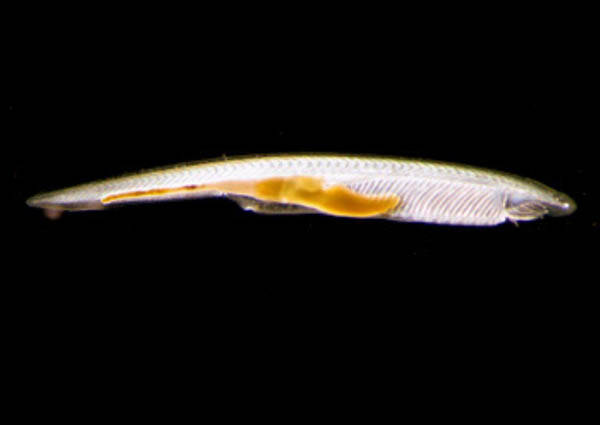The Pacific Lancelet is a warm-temperate marine fish with no subspecies.

The origin of Xiamen Lancelet, Liuwudian, Tong'an County, Xiamen City, is known as the hometown of Lancelet. Xiamen Lancelet is also named after the Wenchang Pavilion on the Liuwudian Island.
Xiamen lancelets are warm-temperate marine fish, living in sea areas with a depth of 8-15 meters, clear water, slow tides, and sandy bottoms. They live in a submerged state; when diving in the sand, they lie down and dive into the loose sandy beach, and then expose the front end to the beach surface. The bottom of this dense area in Liuwudian is: broken shells account for 3.0-4.0%, sand with a diameter of 1.0-1.5 mm accounts for 36.5%, sand with a diameter of 0.5-1.0 mm accounts for 42.5%, and sand with a diameter of less than 0.5 mm accounts for 18.0%. It has weak swimming ability, strong sand drilling ability, and a small range of movement. It cannot live normally when the salinity is lower than 15, and the suitable salinity for growth is 21.0-31.6‰. It is a plant-eating species, feeding on diatoms, the main species of which are round sieve algae, small ring algae, and boat-shaped algae. It feeds by filtering.
Some individuals of Xiamen lancelets reach sexual maturity at the age of 1, and all individuals reach sexual maturity at the age of 3; males and females are different, and fertilization is carried out in vitro. Mature females at the age of 2 lay eggs twice a year, the first time in June-July, and the second time in early December; mature females at the age of 3, some individuals begin to lay eggs at the beginning of the year, enter the peak spawning period in May, and some individuals are still laying eggs in late November. The gonads of individuals at the age of 4 completely disappear, and all die after April every year. Lifespan is 3-4 years.
Xiamen lancelets are high-grade edible protein. Its protein content reaches 70%, and it contains a variety of inorganic salts and iodine. The meat is tender and the taste is refreshing and sweet, which is highly praised by domestic people and international friends. If Xiamen lancelets are fried dry in a pan over low heat and made into thousand crystals, they can be stored for one or two years if properly preserved, and they still have a unique flavor.
Xiamen lancelets are not only edible, but also precious objects for scientific research and teaching. Xiamen lancelets are transitional species between invertebrates and vertebrates. Although they are not the direct ancestors of vertebrates, they may be close to the ancestral lineage of vertebrates, and are important living fossils for studying animal evolution.
The only place in the world where this fish is fished is Liuwudian in Xiamen, Fujian, China. Historically, the highest production was in the 1930s, with an annual output of 250 tons. However, since the 1970s, no fishery has been formed, and this fish is now endangered. In mid-August 2003, the fish was caught in the sea area from Liantouling to Fangji Island in Maoming City, Guangdong Province (an area of more than 150 square kilometers), with a maximum density of 573 fish per square meter; in late July 2004, the fish was caught in the Donghai Island and the eastern and central waters of Leizhou Bay in Zhanjiang City, Guangdong Province, with a maximum density of 760 fish per square meter.
In order to protect the natural resources of Xiamen lancelets, China established a national marine rare species nature reserve in Xiamen City in 2000, and a prefecture-level lancelet nature reserve (an area of 62 square kilometers) in Qingdao City, Shandong Province in 2004. Artificial breeding of this fish has been successful in Qingdao City and Xiamen City, but has not yet entered the production stage.
Listed in the "China National Wildlife Protection List" - Level II.
Listed in the "China National Key Protected Wildlife List" Level II. Only for wild populations.
Protect wild animals and eliminate game.
Maintaining ecological balance is everyone's responsibility!